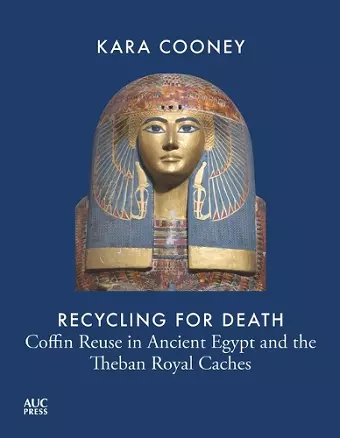Recycling for Death
Coffin Reuse in Ancient Egypt and the Theban Royal Caches
Format:Hardback
Publisher:American University in Cairo Press
Published:27th Aug '24
Currently unavailable, our supplier has not provided us a restock date

A meticulous study of the social, economic, and religious significance of coffin reuse and development during the Ramesside and early Third Intermediate periods, illustrated with over 900 images
Funerary datasets are the chief source of social history in Egyptology, and the numerous tombs, coffins, Books of the Dead, and mummies of the Twentieth and Twenty-first Dynasties have not been fully utilized as social documents, mostly because the data of this time period is scattered and difficult to synthesize. This culmination of fifteen years of coffin study analyzes coffins and other funerary equipment of elites from the Nineteenth to the Twenty-second Dynasties to provide essential windows into social strategies and adaptations employed during the Bronze Age collapse and subsequent Iron Age reconsolidation.
Many Twentieth to Twenty-second Dynasty coffins show evidence of reuse from other, older coffins, as well as obvious marks where gilding or inlay have been removed. Innovative vignettes painted onto coffin surfaces reflect new religious strategies and coping mechanisms within this time of crisis, while advances in mummification techniques reveal an Egyptian anxiety about long-term burial without coffins as a new style of stuffed and painted mummy was developed for the wealthy. It was in the context of necropolis insecurity, economic crisis, and group burial in reused and unpainted chambers that a complex, polychrome coffin style emerged.
The first part of this book focuses on the theory and evidence of coffin reuse, contextualized within the social collapse that characterized the Twentieth and Twenty-first Dynasties. The second part presents photo essays of annotated visual data for over sixty Egyptian coffins from the so-called Royal Caches, most of them from the Egyptian Museum in Cairo.
Illustrated throughout with high-quality images, the line drawings and color and black-and-white photographs are ideal for careful study, especially evidenced in the digital edition, where pages can be enlarged for close examination.
“Cooney’s book is likely to be a standard reference work for some time to come, and is definitely worth the investment. A follow-up volume on coffins for non-royal occupants is eagerly anticipated.” —Campbell Price, Ancient Egypt
"Kara Cooney is the expert on coffin reuse, and in this book she brilliantly synthesizes fifteen years of research. After giving a detailed introduction into the social and religious reasons behind why coffins were reused, how they were acquired, and what was done to them, she focuses on the coffins used to house the New Kingdom royal mummies and the High Priests of Amun. Known since the last years of the nineteenth century, they have, until now, generally been ignored by modern scholars, quietly gathering dust, waiting for Kara, the one person who could do them justice. The result is a superb book, an absolute gem for specialists and students alike, abundantly illustrated in full color throughout, by an excellent scholar at the height of her powers."—David Aston, The Austrian Academy of Sciences, Vienna
"Kara Cooney’s long-awaited book on coffins explains how and why these objects, crucial for the protection, rebirth, and resurrection of the deceased were used and then often recycled and reused for both kings and commoners. The detailed discussions, lavishly illustrated, make for fascinating reading, providing an insight into the economic, social, religious, and cultural life of the ancient Egyptians. A must-have for anyone interested in ancient Egypt."—Salima Ikram, The American University in Cairo
"Kara Cooney has produced a beautifully illustrated exploration of the way that the Egyptians of the eleventh and tenth centuries BC stripped, redecorated, repurposed, and otherwise transmogrified coffins belonging to, or to be reused for, royal and high-priestly individuals. She shows how the minute examination of long-known artefacts can transform our understanding of how they were used and abused over time, for reasons that nevertheless retain aspects of obscurity."—Aidan Dodson, University of Bristol
"While digging in the attic of the Egyptian Museum in Cairo, Kara Cooney found a number of coffins that she discovered had been reused for later internments. This book presents for the first time an in-depth study of these Twenty-first and Twenty-second Dynasty coffins, providing us with critical insight into the phenomena of coffin reuse in ancient Egypt and an invaluable exploration of the religious, social, and economic life of one of the least understood periods of Egyptian history."—Zahi Hawass
“In this book, Kara Cooney presents a dynamic integration of historical and archaeological sources for the power structures of the Twenty-first Dynasty in Thebes, embedding the study of the individual objects found in the Royal Cache into a complex network of material, political, and religious exchanges. By doing so, she opens this field of discussion to new sociological models, as the very fingerprint of each coffin found in the Royal Cache unfolds before our eyes.”—Rogério Sousa, University of Lisbon
"Kara Cooney analyzes the physical evidence of the coffins from the Royal Caches to identify the motivations and changing agendas of those who appropriated and reused them. Based on unprecedented levels of access to the objects, her observations reveal for the first time the surprising complexity of the coffins’ histories and illuminate their possible roles in rituals of legitimation by members of the ruling elite in an age of political uncertainty."—John Taylor, The British Museum
"Kara Cooney’s research, the fruits of which are beautifully presented in Recycling for Death, has revolutionized the approach to funerary culture in modern Egyptological studies: the coffin, which is the most important item of funerary equipment, one that holds within it the miracle of regeneration, becomes a new tool for understanding the mechanisms governing Egyptian society, ideologically and sociologically, politically and economically, and not least, technologically."—Alessia Amenta, Vatican Coffin Project
ISBN: 9781649031280
Dimensions: 279mm x 216mm x 19mm
Weight: unknown
476 pages